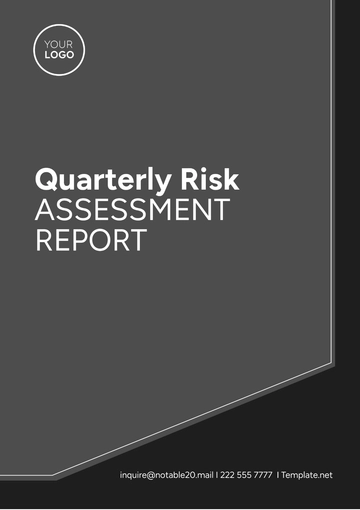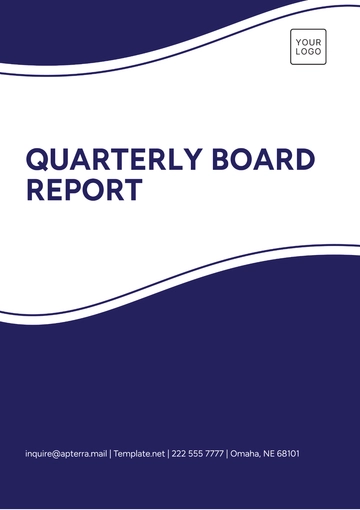Free Sales Quarterly Training Report

I. Executive Summary
The purpose of this report is to provide a comprehensive analysis of the sales training conducted by [Your Company Name] during the previous quarter. Our objective is to evaluate the effectiveness of these training sessions, identify areas of improvement, and develop strategies for future growth. The data we have gathered covers a wide range of aspects, including participation levels, training success rates, and the direct impact of these trainings on our sales figures.
In addition to evaluating our current performance, this report also aims to guide our future initiatives. By analyzing our struggles and achievements, we can calibrate our current sales training methods and develop new strategies that will help elevate our overall sales performance. This continuous process of learning and improvement is crucial for maintaining our competitive edge and achieving our sales goals.
II. Sales Training Overview
It is crucial to showcase a quantitative measure of our team’s learning progress and the impact of our training on our sales performance. The following table showcases the results of the sales training conducted in the past quarter:
Training | Participants | Completion rate | Improved Sales post-training |
|---|---|---|---|
Basic Sales Techniques | 100 | 98% | 20% |
Intermediate Sales Techniques | 70 | 85% | 30% |
Advanced Sales Techniques | 40 | 75% | 40% |
Account Management | 50 | 90% | 35% |
Customer Relationship Management | 60 | 95% | 25% |
The data represents the hard work, dedication, and learning progress of our sales team. High participation rates indicate the team’s eagerness to learn and improve, while the increase in sales post-training demonstrates the direct impact of these programs on our bottom line. Moreover, the high completion rates show the team’s commitment to the training and their ability to grasp and apply the concepts taught. This data not only provides a snapshot of our past performance but also serves as a guide for future improvements. By analyzing this data, we can identify areas of strength and weakness, and accordingly, tailor our training programs to better meet the needs of our sales team and ultimately, drive our sales growth.
III. Key Achievements
A. Basic Sales Techniques
The Basic Sales Techniques training session saw the highest participation. This is a clear indication of the team’s eagerness and commitment to mastering the fundamentals of sales. It also reflects the team’s understanding of the importance of having a solid foundation in basic sales techniques, which is crucial for their future growth and success in the field of sales.
The high participation rate in this training session also demonstrates the effectiveness of our training programs in engaging the team and fostering a learning environment. It shows that our training sessions are well-structured and relevant, meeting the needs and interests of our sales team.
B. Intermediate Sales Techniques
The Intermediate Sales Techniques training led to a remarkable 30% increase in sales. This is a significant achievement that demonstrates the effectiveness of this training in enhancing the team’s sales skills. It shows that the team was able to successfully apply the techniques and strategies learned during the training to their sales activities, leading to a substantial increase in sales.
This achievement also underscores the direct impact of our training programs on our bottom line. It shows that investing in our team’s development and providing them with the necessary training can lead to tangible results and contribute to the company’s financial success.
C. Customer Relationship Management
The successful completion of the Customer Relationship Management training by 95% of participants is a testament to the team’s commitment to improving their customer relationship management skills. It shows that the team values the importance of building strong relationships with customers, which is key to customer retention and business growth.
This achievement also highlights the effectiveness of our training content and methods. It indicates that our training programs are well-designed and effective in imparting the necessary skills and knowledge to our team, enabling them to successfully complete the training and apply what they’ve learned to their roles.
D. Account Management
Following the Account Management discussion, there was a 35% improvement in sales. This improvement indicates that the training effectively equipped the team with the necessary skills for successful account management. It shows that the team was able to apply the strategies and techniques learned during the training to manage accounts more effectively, leading to an increase in sales.
This achievement also demonstrates the value of our training programs. It shows that our training programs not only equip the team with the necessary skills but also contribute to the company’s financial success by driving sales growth.
E. Advanced Sales Techniques
The Advanced Sales Techniques training showed the highest increase in sales figures. This achievement demonstrates the value of advanced training in driving sales growth and enhancing the team’s sales techniques. It shows that the team was able to effectively apply the advanced techniques learned during the training to their sales activities, leading to a significant increase in sales.
This achievement also underscores the effectiveness of our training programs. It shows that our training programs are well-designed and effective in equipping the team with the necessary skills and knowledge, enabling them to excel in their roles and contribute to the company’s success.
IV. Areas of Struggle
A. Advanced Sales Techniques and Account Management Trainings
One of the struggles we identified was the lower participation in Advanced Sales Techniques and Account Management trainings. This could be due to a variety of reasons such as the perceived difficulty of these trainings, scheduling conflicts, or a lack of awareness about the importance of these skills.
To address this, we need to investigate the reasons behind this lower participation rate. This could involve conducting surveys or feedback sessions with the team to understand their concerns or barriers to participation.
Based on the insights gathered, we can then take steps to encourage more team members to participate in these advanced trainings. This could involve adjusting the training schedule, providing additional support or resources, or conducting awareness sessions about the importance of these skills for their roles and career growth.
B. Basic Sales Techniques Training
Despite high participation, the Basic Sales Techniques training resulted in the least increase in sales figures. This suggests that while the team is eager to learn, the training may not be effectively translating into improved sales performance.
To address this, we need to review the content and delivery of this training. This could involve revisiting the training objectives, content, teaching methods, and assessment techniques to ensure they are aligned with the team’s needs and learning styles.
C. Advanced Sales Technique Session
There was a lower completion rate in the Advanced Sales Technique session. This could indicate that the training is too challenging, not engaging enough, or not meeting the team’s expectations or needs.
To address this, we need to review the content and structure of this training. This could involve adjusting the difficulty level, incorporating more interactive elements, or tailoring the content to better meet the team’s needs and interests.
D. Intermediate Sales Techniques Training
The Intermediate Sales Techniques training could still use attention to detail. This suggests that while the training is effective in improving sales, there may be areas that are not being adequately covered.
To address this, we need to review this training to ensure it is comprehensive and covers all necessary areas in sufficient detail. This could involve updating the training content, incorporating more case studies or real-world examples, or providing additional resources for self-study.
We could also consider providing more opportunities for feedback and discussion during the training to ensure that all topics are thoroughly understood and any questions or concerns are addressed promptly.
E. Overall Improvement of Sales Post-Training
There is a need to improve the overall improvement of sales post-training. This indicates that while our training programs are effective in imparting skills, they may not be translating into the expected improvement in sales.
To address this, we need to investigate the reasons behind this and take steps to ensure that the skills learned during training are effectively applied in the field. This could involve conducting post-training assessments, providing ongoing coaching or support, or creating a more supportive environment for the application of new skills.
We could also consider revising our training evaluation methods to better measure the impact of training on sales performance. This could involve tracking individual performance over time, conducting regular feedback sessions, or using more sophisticated analytics to measure the impact of training on sales performance.
V. Next Steps
These steps are aimed at addressing the areas of struggle identified, leveraging the key achievements, and continuously improving our sales training programs:
A. Increasing Participation in Advanced Trainings
One of the key areas that need improvement is the participation rate in advanced trainings. To address this, we plan to conduct awareness sessions highlighting the importance and benefits of these trainings. We will also look into scheduling these sessions at more convenient times or offering them in different formats to accommodate the needs of our team.
B. Translating Learned Techniques into Tangible Sales Growth
Another important step is to ensure that the techniques learned during training translate into tangible sales growth. This could involve providing more post-training support, such as coaching or mentoring, to help the team apply what they’ve learned. We could also consider setting up a system for tracking and rewarding the application of new skills in the field.
C. Continuous Improvement of Training Methods and Content
We also recognize the need for continuous improvement of our training methods and content. This involves staying updated with the latest sales techniques and strategies, and integrating them into our training programs. We will also periodically reassess our training approach and seek feedback from our sales team to identify gaps and understand their specific training requirements.
D. Cultivating a Culture of Continuous Learning and Improvement
Lastly, we believe in cultivating a culture of continuous learning and improvement. This involves encouraging our team to take ownership of their learning and development, and providing them with the necessary resources and support. By doing so, we ensure that our sales team is equipped with the necessary skills to excel in their roles and significantly contribute to our company’s success.
VI. Conclusion
In conclusion, this Report of [Your Company Name] has provided valuable insights into our sales training programs. We have identified key achievements that highlight the effectiveness of our training and the hard work and dedication of our sales team. At the same time, we have also identified areas of struggle that present opportunities for improvement.
Moving forward, we will take the necessary steps to address these areas of struggle and leverage our key achievements to continuously improve our sales training programs. We believe in the importance of continuous learning and improvement, and we are committed to providing our sales team with the necessary training and support to excel in their roles and contribute to our company’s success. This ongoing commitment to our team’s development is crucial for maintaining our competitive edge and achieving our sales goals.
- 100% Customizable, free editor
- Access 1 Million+ Templates, photo’s & graphics
- Download or share as a template
- Click and replace photos, graphics, text, backgrounds
- Resize, crop, AI write & more
- Access advanced editor
The Sales Quarterly Training Report Template from Template.net is an editable tool that helps you track and analyze your quarterly sales training! With our intuitive AI Editor Tool, you can easily modify it to suit your needs. This customizable template helps you manage your sales training activities effectively! Access now!
You may also like
- Sales Report
- Daily Report
- Project Report
- Business Report
- Weekly Report
- Incident Report
- Annual Report
- Report Layout
- Report Design
- Progress Report
- Marketing Report
- Company Report
- Monthly Report
- Audit Report
- Status Report
- School Report
- Reports Hr
- Management Report
- Project Status Report
- Handover Report
- Health And Safety Report
- Restaurant Report
- Construction Report
- Research Report
- Evaluation Report
- Investigation Report
- Employee Report
- Advertising Report
- Weekly Status Report
- Project Management Report
- Finance Report
- Service Report
- Technical Report
- Meeting Report
- Quarterly Report
- Inspection Report
- Medical Report
- Test Report
- Summary Report
- Inventory Report
- Valuation Report
- Operations Report
- Payroll Report
- Training Report
- Job Report
- Case Report
- Performance Report
- Board Report
- Internal Audit Report
- Student Report
- Monthly Management Report
- Small Business Report
- Accident Report
- Call Center Report
- Activity Report
- IT and Software Report
- Internship Report
- Visit Report
- Product Report
- Book Report
- Property Report
- Recruitment Report
- University Report
- Event Report
- SEO Report
- Conference Report
- Narrative Report
- Nursing Home Report
- Preschool Report
- Call Report
- Customer Report
- Employee Incident Report
- Accomplishment Report
- Social Media Report
- Work From Home Report
- Security Report
- Damage Report
- Quality Report
- Internal Report
- Nurse Report
- Real Estate Report
- Hotel Report
- Equipment Report
- Credit Report
- Field Report
- Non Profit Report
- Maintenance Report
- News Report
- Survey Report
- Executive Report
- Law Firm Report
- Advertising Agency Report
- Interior Design Report
- Travel Agency Report
- Stock Report
- Salon Report
- Bug Report
- Workplace Report
- Action Report
- Investor Report
- Cleaning Services Report
- Consulting Report
- Freelancer Report
- Site Visit Report
- Trip Report
- Classroom Observation Report
- Vehicle Report
- Final Report
- Software Report





























